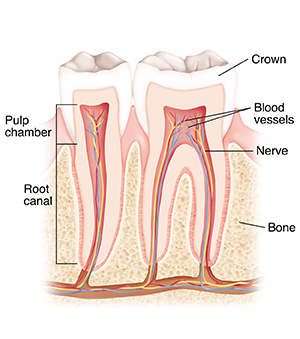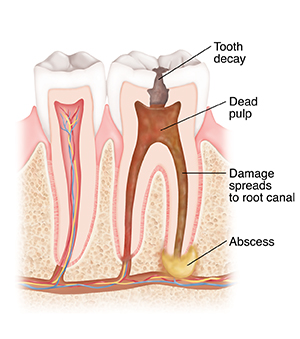Understanding Root Canal: Overview
Most of us try to keep our teeth clean and looking nice. But we don’t think much about what’s inside our teeth—until something goes wrong. When problems develop inside a tooth, root canal therapy may be the only way to save it.
The whole tooth
The parts of a tooth include:
-
The crown. This is the part of the tooth that you can see above the gumline. It has a hard surface (enamel) that is used for biting and chewing. It is also protects the tooth from heat.
-
The root. Below the gumline, the root anchors the tooth to the bone.
-
The pulp. The middle of the tooth (the pulp chamber) contains the pulp. This soft tissue is made up mainly of blood vessels and nerves.
-
The root canal. This is the pathway that the nerves and blood vessels use to travel into and within the tooth from the jawbone.

Pulp problems
Pulp problems most often happen when decay or an injury damages the tooth’s crown and exposes the pulp. Once this happens, the pulp becomes inflamed. Bacteria in the mouth can infect and kill the pulp. The infection can then spread throughout the pulp chamber and the root canal. If it reaches the tip of the root, it can invade the bone. In some cases, it forms a pocket of pus (an abscess). If this process isn’t stopped, it leads to bone and tooth loss.

Choosing root canal therapy
Root canal therapy can save a tooth whose pulp has died. The earlier the tooth is treated, the less pain, trouble, and expense you’ll face. Many people believe that root canal therapy is painful, but this is not always the case The treatment rarely causes any more discomfort than other dental procedures such as fillings. In some cases you may have mild soreness for a few days.
An overview of treatment
Root canal therapy consists of removing the inflamed or infected pulp. The first step is to make an opening in the crown. The dentist then cleans the pulp chamber and root canals. These spaces are later filled with a sealer and a rubber-like substance called gutta-percha . This acts as a permanent bandage. Finally, restoring the crown of the tooth protects the tooth from more damage or infection. The goals of treatment are to:
-
Relieve pain and other symptoms
-
Stop any infection and prevent its spread
-
Save the tooth from having to be extracted
Risks and possible complications
Root canal therapy has a high rate of success. If complications do happen, they are often minor and can be treated. Risks and possible complications include:
-
Pain or infection
-
Reaction to medicine or anesthesia
-
Sore jaw joint and nearby muscles
-
Broken (separated) dental tool in a root canal
-
Cracks in the tooth root that were not seen before
-
Need for more treatment, such as endodontic surgery
Online Medical Reviewer:
Jessica Gotwals RN BSN MPH
Online Medical Reviewer:
Michael Kapner MD
Online Medical Reviewer:
Rita Sather RN
Date Last Reviewed:
8/1/2022
© 2000-2024 The StayWell Company, LLC. All rights reserved. This information is not intended as a substitute for professional medical care. Always follow your healthcare professional's instructions.